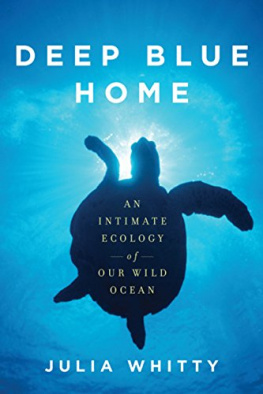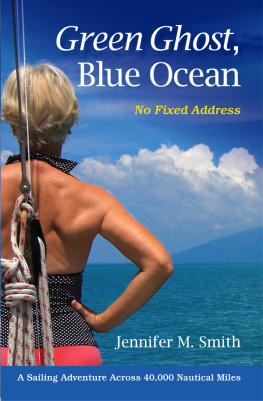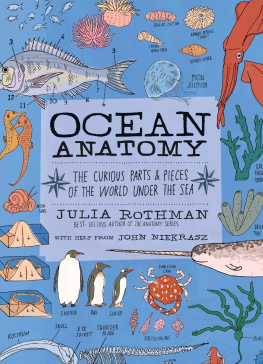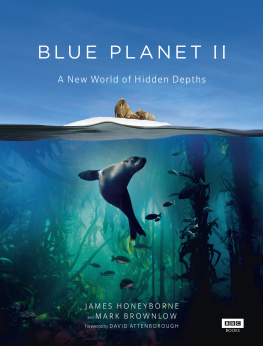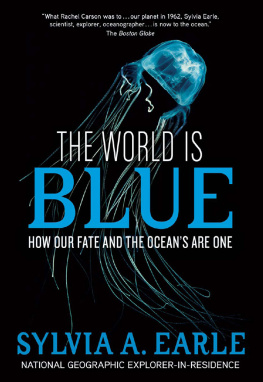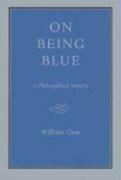Julia Whitty - Deep Blue Home: An Intimate Ecology of Our Wild Ocean
Here you can read online Julia Whitty - Deep Blue Home: An Intimate Ecology of Our Wild Ocean full text of the book (entire story) in english for free. Download pdf and epub, get meaning, cover and reviews about this ebook. year: 2010, publisher: Houghton Mifflin Harcourt, genre: Home and family. Description of the work, (preface) as well as reviews are available. Best literature library LitArk.com created for fans of good reading and offers a wide selection of genres:
Romance novel
Science fiction
Adventure
Detective
Science
History
Home and family
Prose
Art
Politics
Computer
Non-fiction
Religion
Business
Children
Humor
Choose a favorite category and find really read worthwhile books. Enjoy immersion in the world of imagination, feel the emotions of the characters or learn something new for yourself, make an fascinating discovery.
- Book:Deep Blue Home: An Intimate Ecology of Our Wild Ocean
- Author:
- Publisher:Houghton Mifflin Harcourt
- Genre:
- Year:2010
- Rating:4 / 5
- Favourites:Add to favourites
- Your mark:
- 80
- 1
- 2
- 3
- 4
- 5
Deep Blue Home: An Intimate Ecology of Our Wild Ocean: summary, description and annotation
We offer to read an annotation, description, summary or preface (depends on what the author of the book "Deep Blue Home: An Intimate Ecology of Our Wild Ocean" wrote himself). If you haven't found the necessary information about the book — write in the comments, we will try to find it.
Julia Whitty: author's other books
Who wrote Deep Blue Home: An Intimate Ecology of Our Wild Ocean? Find out the surname, the name of the author of the book and a list of all author's works by series.
Deep Blue Home: An Intimate Ecology of Our Wild Ocean — read online for free the complete book (whole text) full work
Below is the text of the book, divided by pages. System saving the place of the last page read, allows you to conveniently read the book "Deep Blue Home: An Intimate Ecology of Our Wild Ocean" online for free, without having to search again every time where you left off. Put a bookmark, and you can go to the page where you finished reading at any time.
Font size:
Interval:
Bookmark:
HOUGHTON MIFFLIN HARCOURT
BOSTON NEW YORK
2010
Copyright 2010 by Julia Whitty
ALL RIGHTS RESERVED
For information about permission to reproduce selections from this book,
write to Permissions, Houghton Mifflin Harcourt Publishing Company,
215 Park Avenue South, New York, New York 10003.
www.hmhbooks.com
Library of Congress Cataloging-in-Publication Data
Whitty, Julia.
Deep blue home : an intimate ecology of our wild ocean / Julia Whitty.
p. cm.
Includes bibliographical references.
ISBN 978-0-618-11981-3
1. Ocean currents. 2. Deep-sea ecology. 3. Whitty, JuliaTravel. I. Title.
GC 231.2. W 49 2010
551.46dc22 2009047558
Book design by Brian Moore
Printed in the United States of America
DOC 10 9 8 7 6 5 4 3 2 1
Lines from "Lament for the Dorsets" by Al Purdy, from Beyond Remembering;
The Collected Poems of Al Purdy. Copyright 2000 by Al Purdy. Reprinted by
permission of Harbour Publishing.
Lines from "No More Fish, No Fishermen" by Shelley Posen. Copyright 1996 by
Shelley Posen, Well Done Music, BMI. Reprinted by permission of Shelley Posen.
Excerpt from "Terror in Black and White" by Robert L. Pitman and Susan J.
Chivers, reprinted from Natural History, December 1998/January 1999. Copyright
1998 by Natural History Magazine, Inc. Reprinted by permission of Natural
History Magazine.
Portions of this book first appeared in Mother Jones as "The Fate of the Ocean"
(March/April 2006), "The Thirteenth Tipping Point" (November/December
2006), and "Gone" (May/June 2007).
In memory of my father, Mark Stephens Whitty, who grew up sailing the wild Southern Ocean off Tasmania and who first took me offshore and taught me about wind, waves, and the power of coming about
Part One: Isla Rasa
1. The Very Air Miraculous
2. The River That Was Nowhere and Everywhere
3. Another Heaven
4. Hunger Island
5. The Ornament of the Body
6. One Hundred Days of Solitude
7. Whorls
8. The Unreefed World
9. The Epitome of Unrestrained Freedom
10. Mirage
11. Emotional Ecology
12. The Anti-Bodies of Quiet
13. Everything Is Already Brilliant
Part Two: The Underwater Rivers of the World
14. The Distant Geography of Water
15.The Ecumenical Sea
16. Deepwater Formation
17. The Tempest from the Eagle's Wings
18. One Meritorious Act
19. Jump Cut
20. Lament for the Thirty Million
21. All Time Is Now
22. Trophic Cascade
23. Bone Rafters
24. Soundsabers
25. Salting Down the Lean Missionary
26.The Existence of a World Previous to Ours
27. Reading God
28. Nemesis
29. The Inexplicable Waves
30. At the End of Hunger
Part Three: The Airborne Ocean
31. Serpent Cave
32. Black Mirror
Acknowledgments
Notes
O troupe of little vagrants of the world, leave your footprints in my words.
RABINDRANATH TAGORE
Stray Birds
W ORKING MY WAY back to the casita, the little stone hut we call home, I hop the boulders along the rocky shoreline, where relatively few of the 300,000 seabird inhabitants of Isla Rasa choose to nest. Even so, some Heermann's gullsfirst-year breeders or latecomers or reclusesare nestled among these outermost rocks, napping on their eggs, confident of privacy, only to be rudely awakened by the approach of my dusty shoes. One after another, as if yanked on invisible strings, they burst into flight, webbed feet paddling, wings rowing backward, yowling aow-aow-aow in alarm and loosing globs of guano. I've been here for a month and still feel guilty about disturbing them.
It's late on an April day, and some strange trick of atmospherics is providing a hypnotic illusion. Perhaps it is "the very air miraculous" that John Steinbeck wrote of during his travels in these parts in 1940 with the marine biologist Ed Ricketts. Here and now, sea and sky have merged into a pewter veil so thick the horizon line is erased. Yet the air is actually clear enough that flying birds cast black shadows on the icelike sea surface, invisible except for the shadowsa paradox of clarity and confusion created by a form of fog I've never seen beforenot a whiteout in snow but a silverout in the subtropics, some 350 miles southeast of San Diego and 1,000 miles northwest of Mexico City.
I pause to study the effects of disorientation in a familiar landscape. At other times and placesin the weightlessness of underwater at night, for instanceI've lost enough sense of direction that vertigo upends my bearings. But here in the foggy heart of the Gulf of California, I'm anchored to Earth by gravity and affixed to the ocean by the sound of slap-happy waves. What's adrift here isn't the compass but time. As if a brontosaurus could unfurl its neck from beneath the waves or a pterodactyl flap ashore.
And then a prehistoric head does punch through the surface ten feet offshore, followed by the longitudinal ridges of a shell. It's a leatherback sea turtle, a creature straight out of prehistory, an inhabitant of the deep blue home for at least 110 million years, whose ancestors once shared the ocean with dinosaurs. From the length of the tail, this one appears to be a female. In the last pulse of light before darkness, she forms a perfect mirror-image twin with the surface: a two-headed turtle, jellyfish tentacles streaming from the corners of her mouths, like cellophane noodles in a silver broth.
The scene is transfixing. And not only because she's the biggest sea turtle I've ever seen, maybe six feet long and, I guess, a thousand pounds. Not only because leatherback turtles are rare or because it's the end of the day and living outdoors makes me perpetually hungry and right now even jellyfish soup sounds good. But because of the tableau of cause and effect rippling from it.
The turtle sculls at a leisurely rate, dipping her head, heaving the long tentacles into the air, swallowing, eyes closed to avoid the stings. As she chews the bell of the jellyfish underwater, the curve of her leathery backit's not really a shell at allpitches and yaws above the water line like a capsized dinghy. The sight is intriguing enough that an elegant tern, another breeder on Isla Rasa, detours from its flight path between feeding ground and nesting colony to hover quizzically on butterfly wings. Other terns notice this one's attentiveness, and a small flock coalesces in the air, wings open, heads down, all eyes focused below, where a school of damselfish bounces off the turtle's flippers, picking her skin clean. A few Heermann's gulls congregate on the wet rocks, slipping on algae, jostling for position, until one jumps in and paddles counterclockwise around the turtle as she drifts clockwise on the currents circling the island. The terns sideslip through the air to keep up.
Just offshore, the entourage twirls into a floating raft of eared grebes, thousands of small water birds paddling in close formation. They dive en masse when the turtle approaches, their webbed feet stroking the surface before disappearing into the ripples of their own making, then pop up in the same tight formation a hundred feet away. The flock will be here for only another day or two, en route to California's Salton Sea, three hundred miles to the north. It will fly there tonight or tomorrow night, traveling nonstop, then make another nonstop flight to California's Mono Lake, then split into smaller groups headed for their birth lakes scattered through the Canadian Rockies and northern Great Plains. Between here and there they'll cinch the disparate bodies of water together as surely as threads in a necklace of blue beads.
Font size:
Interval:
Bookmark:
Similar books «Deep Blue Home: An Intimate Ecology of Our Wild Ocean»
Look at similar books to Deep Blue Home: An Intimate Ecology of Our Wild Ocean. We have selected literature similar in name and meaning in the hope of providing readers with more options to find new, interesting, not yet read works.
Discussion, reviews of the book Deep Blue Home: An Intimate Ecology of Our Wild Ocean and just readers' own opinions. Leave your comments, write what you think about the work, its meaning or the main characters. Specify what exactly you liked and what you didn't like, and why you think so.

